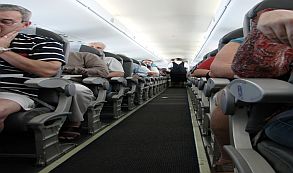The International Air Transport Association (IATA) announced global passenger traffic results for November showing continued strong traffic growth above the 10-year average rate of 5.6%. Total revenue passenger kilometers (RPKs) rose 5.9% compared to the year-ago period. Although below the October rate of 7.1%, this largely was owing to the impact of factors that are expected to be short-lived, including the cessation of operations by Transaero, Russia"™s second largest carrier, and labor strikes at Lufthansa.
The healthy demand continued despite some softening in economic growth, in large part owing to falling fares. Data for the first ten months of the year show a 5% decline in average fares in currency-adjusted terms. November capacity (available seat kilometers or ASKs) increased by 4.2%, and load factor rose 1.3 percentage points to 78.0%.
"Consumers continue to benefit from lower fares, which are spurring demand. The economy benefits from the stimulus to consumer spending. And airlines are starting to achieve minimum acceptable profit levels. It"™s good news all around, but as we open 2016, economic risks are mounting," said Tony Tyler, IATA"™s Director General and CEO.
| Nov 2015 vs. Nov 2014 | RPK Growth | ASK Growth | PLF |
| International | 5.6% | 4.1% | 76.2% |
| Domestic | 6.4% | 4.4% | 81.1% |
| Total Market | 5.9% | 4.2% | 78.0% |
| YTD 2015 vs. YTDÂ 2014 | RPK Growth | ASK Growth | PLF |
| International | 6.8% | 6.1% | 79.8% |
| Domestic | 6.4% | 5.3% | 81.6% |
| Total Market | 6.7% | 5.8% | 80.5% |
International Passenger Markets
November international passenger demand rose 5.6% compared to November 2014, with airlines in all regions recording growth. Total capacity climbed 4.1%, and load factor edged up 1.1 percentage points to 76.2%.
- Asia-Pacific airline"™ November traffic climbed 7.9% compared to the year-ago period. Capacity increased 5.7% and load factor rose 1.6 percentage points to 76.2%. Weakness in Emerging Asia trade activity, as well as slower than expected growth in China, appear not to be impacting international RPKs for Asia-Pacific carriers.
- European carriers saw demand increase by 2.2%. The lower growth primarily was triggered by the aforementioned shutdown of Transaero and labor issues at Lufthansa. Capacity slipped 0.1% and load factor rose 1.7 percentage points to 79.5%, highest among the regions.
- North American airline"™ traffic climbed 2.1% in November. While this was weaker than the year-to-date trend of 3.4%, capacity dipped 0.2%, boosting load factor 1.8 percentage points to 78.4%.
- Middle East carriers had a 9.8% demand increase in November. Capacity rose slightly faster at 11.5% causing load factor to dip 1.0 percentage point to 69.4%. Business conditions across the non-oil producing private sectors of the UAE and Saudi Arabia appear to be strengthening, and this should help sustain solid expansion in air passenger demand for local carriers.
- Latin American airlines saw November traffic climb 10.7% compared to November 2014. Capacity increased by 10.1%, pushing load factor up 0.3 percentage points to 78.9%. Latin American carriers have seen robust growth in air travel, but significant declines in yields, with weakness in the key economies of Brazil and Argentina, placing significant downward pressure on financial performance.
- African airline"™ experienced their fifth consecutive month of positive traffic growth in November, posting a 12.2% rise compared to November 2014. However, the trend for the year-to-date so far remains weak, with growth of just 1.3% reflecting adverse economic developments in parts of the continent, including in Nigeria, which is highly reliant on oil revenues. Over the past few months, exports from Africa have held up better than they did earlier in 2015, and this could be helping boost international air travel on the region"™s carriers. Capacity rose 9.8% and load factor rose 1.5 percentage points to 65.1%.
Domestic Passenger Markets
Domestic travel demand rose 6.4% in November compared to November 2014 but results were mixed, with Brazil, Russia and Japan all showing declines. Domestic capacity climbed 4.4%, and load factor improved 1.6 percentage points to 81.1%.
| Nov 2015 vs Nov 2014 | RPK Growth | ASK Growth | PLF |
| Australia | 1.9% | 1.0% | 79.4% |
| Brazil | -7.9% | -4.1% | 78.0% |
| China P.R | 8.4% | 7.7% | 80.4% |
| India | 25.1% | 19.8% | 83.6% |
| Japan | -1.2% | -2.5% | 71.2% |
| Russian Federation | -7.1% | -10.6% | 71.7% |
| US | 9.1% | 5.3% | 84.5% |
| Domestic | 6.4% | 4.4% | 81.1% |
- India"™s strong results reflect notable increases in service frequencies, ongoing economic strength and the timing of the Diwali holiday, which occurred in October in 2014.
- Air travel in Japan declined but measures of manufacturing activity improved strongly during the month, which should support rising passenger demand.
The Bottom Line: "The airline industry is delivering solid financial and operational performance. The industry"™s return on capital for 2015 and 2016 is expected to exceed its cost of capital"”a very rare occurrence. This means we are on the path toward financial sustainability. Consumers are benefitting from lower fares, and airlines are able to invest in new aircraft that are more comfortable, quieter and more environmentally friendly.
Passenger demand remains strong; however, the ongoing turmoil in the global financial markets and concerns over slowing economic growth in China are casting a shadow over the New Year.
2016 will be a historic year for aviation as States come together at the 39th International Civil Aviation Organization Assembly to discus"”and I hope agree"”a market-based-measure that will allow airlines to achieve carbon-neutral growth from 2020," said Tyler.



